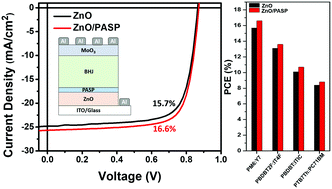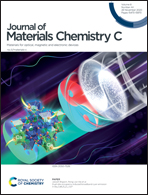A biopolymeric buffer layer improves device efficiency and stability in inverted organic solar cells†
Abstract
Interfacial modification is a key approach to improve performance in organic photovoltaic devices. Here, we demonstrate an environmentally friendly interfacial modifier, polyaspartic acid (PASP), which is inserted between ZnO and photoactive layers in inverted organic solar cells. The power conversion efficiency (PCE) of these solar cells based on a PM6:Y7 bulk heterojunction is boosted from 15.7% to 16.6%, due to a concurrently higher short-circuit current and fill factor. Revealed by electron spin resonance (ESR) spectroscopy coupled with charge transport measurements, the existence of an interfacial doping effect in ZnO/PASP induced by PASP was examined. An appropriate work function and surface wettability with a homogenous surface morphology are observed in ZnO/PASP electron transporting layers (ETLs). Furthermore, the optimized ETLs show universal applicability and enable better device stability. This work offers exciting prospects for using environmentally friendly materials to enrich our understanding of the interfacial properties of inverted OSCs.



 Please wait while we load your content...
Please wait while we load your content...